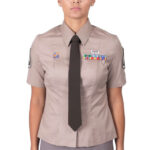The uniforms of the US Marine Corps have a storied history, evolving significantly over time to meet the changing demands of warfare and reflect the identity of this elite fighting force. In the early days, the gear carried by Marines was both practical and essential for survival and combat effectiveness. This article delves into some key components of the historical Us Marine Uniforms, shedding light on the equipment they relied upon.
Marines depended on various bags to carry their necessities. One common type was the haversack, a simple white linen or muslin bag. These bags, typically around 12 x 12 inches, served as a general-purpose carrier for food rations, eating utensils, and small personal belongings. A flap, secured with three metal buttons, kept the contents protected.
For larger loads, Marines utilized the knapsack. Constructed from heavy linen cloth folded and sewn into a square shape, the knapsack was designed to transport bulkier items. This included sleeping gear for nights in the field, hygiene kits for personal cleanliness, spare clothing for varying conditions, and additional personal items. Each side of the knapsack had a sewn-in cloth pouch for organization. To enhance weather resistance, the knapsack flap was often painted, and it was a common practice to display the regiment’s crest on this painted flap, fostering unit pride and identification.
Hydration was crucial, and the canteen was an indispensable part of a Marine’s kit. These came in a couple of primary forms. One type was a wooden drum canteen, which was carried using a leather strap. Another common design was a kidney-shaped tin canteen, slung from a simple cord for easy access.
Essential for carrying ammunition and weaponry, the equipment belts were crafted from ‘whitened buff’ or natural leather and were adjustable for a secure fit. A key belt was worn diagonally from the left shoulder to the right hip. This belt was specifically designed to bear the weight of the cartridge box. The cartridge box itself was a black leather pouch, often referred to as a soft pouch. Inside, a wooden block with precisely drilled holes held 18 to 24 pre-rolled paper cartridges, ensuring ammunition was organized and readily available. A sturdy black saddle-leather flap covered the pouch, providing vital protection against the elements and preventing moisture damage to the cartridges.
Another critical piece of equipment was the bayonet. This weapon was attached to the Marine’s waist belt using a leather frog, essentially a loop or slot designed to hold the bayonet securely. While a second shoulder belt was gaining popularity, extending from the right shoulder to the left hip, Marines often preferred the continued use of the waist belt for bayonet and other attachments, maintaining a familiar and trusted system.
Finally, swords were not standard-issue for all Marines but were significant indicators of rank. Only Marine officers and sergeants were authorized to carry swords. These were not merely ceremonial; they served as personal defense weapons, symbolizing authority and status within the Corps.
In conclusion, the early US Marine uniforms were more than just clothing; they were a system of essential gear designed for functionality and the demands of military life. From bags for carrying supplies to belts for weapons and ammunition, and swords denoting rank, each component played a vital role in the Marine’s effectiveness and identity. Understanding these elements provides valuable insight into the historical context of the US Marine Corps and the evolution of their distinguished uniforms.

